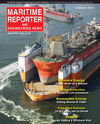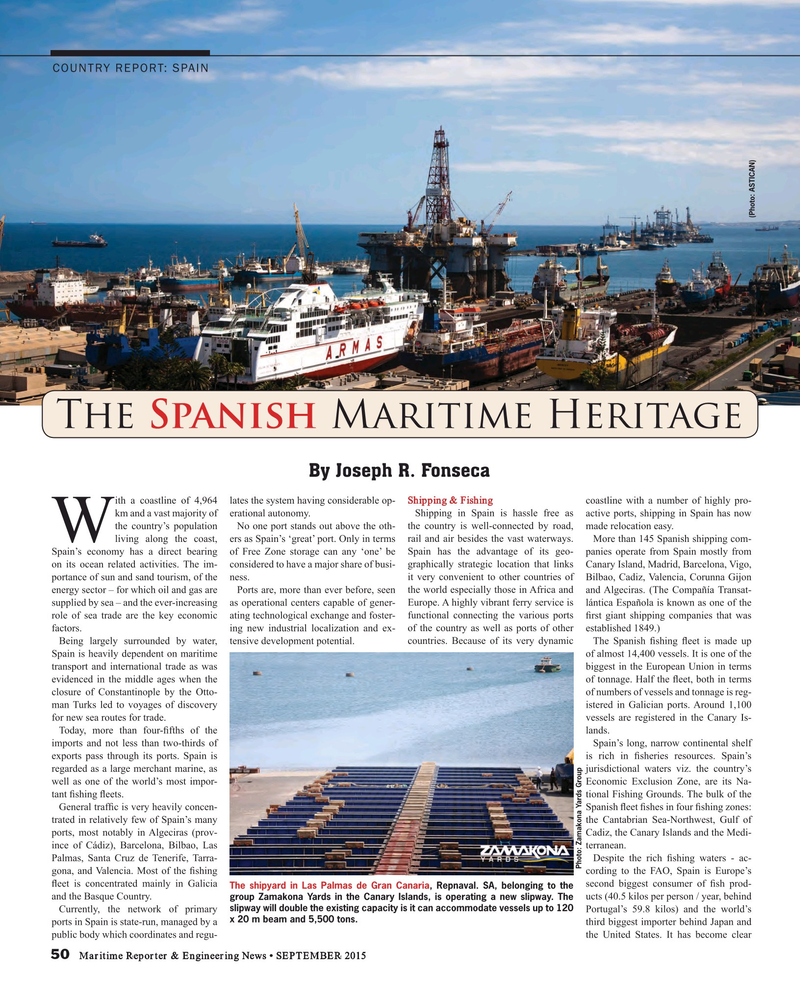
Page 50: of Maritime Reporter Magazine (September 2015)
Offshore Energy Technologies
Read this page in Pdf, Flash or Html5 edition of September 2015 Maritime Reporter Magazine
COUNTRY REPORT: SPAIN (Photo: ASTICAN)
The Spanish Maritime Heritage
By Joseph R. Fonseca ith a coastline of 4,964 lates the system having considerable op- Shipping & Fishing coastline with a number of highly pro- km and a vast majority of erational autonomy. Shipping in Spain is hassle free as active ports, shipping in Spain has now the country’s population No one port stands out above the oth- the country is well-connected by road, made relocation easy. living along the coast, ers as Spain’s ‘great’ port. Only in terms rail and air besides the vast waterways. More than 145 Spanish shipping com-
W
Spain’s economy has a direct bearing of Free Zone storage can any ‘one’ be Spain has the advantage of its geo- panies operate from Spain mostly from on its ocean related activities. The im- considered to have a major share of busi- graphically strategic location that links Canary Island, Madrid, Barcelona, Vigo, portance of sun and sand tourism, of the ness. it very convenient to other countries of Bilbao, Cadiz, Valencia, Corunna Gijon energy sector – for which oil and gas are Ports are, more than ever before, seen the world especially those in Africa and and Algeciras. (The Compañía Transat- supplied by sea – and the ever-increasing as operational centers capable of gener- Europe. A highly vibrant ferry service is lántica Española is known as one of the role of sea trade are the key economic ating technological exchange and foster- functional connecting the various ports ? rst giant shipping companies that was factors. ing new industrial localization and ex- of the country as well as ports of other established 1849.)
Being largely surrounded by water, tensive development potential. countries. Because of its very dynamic The Spanish ? shing ? eet is made up
Spain is heavily dependent on maritime of almost 14,400 vessels. It is one of the transport and international trade as was biggest in the European Union in terms evidenced in the middle ages when the of tonnage. Half the ? eet, both in terms closure of Constantinople by the Otto- of numbers of vessels and tonnage is reg- man Turks led to voyages of discovery istered in Galician ports. Around 1,100 for new sea routes for trade. vessels are registered in the Canary Is-
Today, more than four-? fths of the lands. imports and not less than two-thirds of Spain’s long, narrow continental shelf exports pass through its ports. Spain is is rich in ? sheries resources. Spain’s regarded as a large merchant marine, as jurisdictional waters viz. the country’s well as one of the world’s most impor- Economic Exclusion Zone, are its Na- tant ? shing ? eets. tional Fishing Grounds. The bulk of the
General traf? c is very heavily concen- Spanish ? eet ? shes in four ? shing zones: trated in relatively few of Spain’s many the Cantabrian Sea-Northwest, Gulf of ports, most notably in Algeciras (prov- Cadiz, the Canary Islands and the Medi- ince of Cádiz), Barcelona, Bilbao, Las terranean.
Palmas, Santa Cruz de Tenerife, Tarra- Despite the rich ? shing waters - ac-
Photo: Zamakona Yards Group gona, and Valencia. Most of the ? shing cording to the FAO, Spain is Europe’s ? eet is concentrated mainly in Galicia second biggest consumer of ? sh prod-
The shipyard in Las Palmas de Gran Canaria, Repnaval. SA, belonging to the and the Basque Country. ucts (40.5 kilos per person / year, behind group Zamakona Yards in the Canary Islands, is operating a new slipway. The slipway will double the existing capacity is it can accommodate vessels up to 120
Currently, the network of primary Portugal’s 59.8 kilos) and the world’s x 20 m beam and 5,500 tons. ports in Spain is state-run, managed by a third biggest importer behind Japan and public body which coordinates and regu- the United States. It has become clear 50 Maritime Reporter & Engineering News • SEPTEMBER 2015
MR #9 (50-57).indd 50 MR #9 (50-57).indd 50 9/8/2015 9:20:26 AM9/8/2015 9:20:26 AM

 49
49

 51
51
